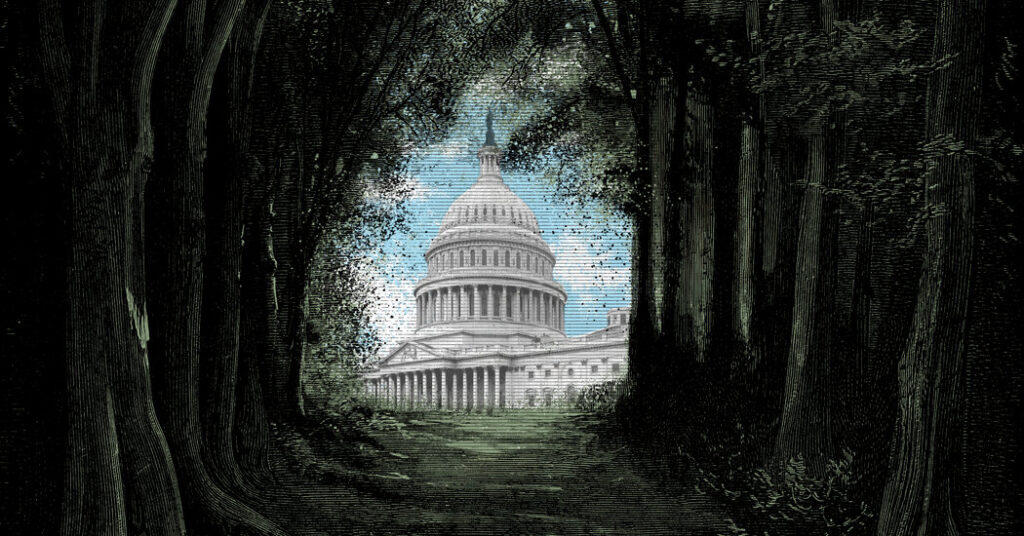When you think about states that might throw Democrats a lifeline, Alaska hardly comes to mind first.
But I could argue that it will play a crucial part in the party’s quest to reclaim a Senate majority next year. And that Democrats will prevail.
Hear me out. One of Alaska’s two Republican senators, Dan Sullivan, is up for re-election. His Democratic opponent might be Mary Peltola, a former member of Congress who was defeated in her statewide race to be re-elected to Alaska’s sole seat in the House by just two percentage points last year. Peltola lost in what turned out to be a chilly climate for Democrats, but 2026 is shaping up to be colder for Republicans. So she — or another reasonably popular Democrat — should have a shot, especially given demographic changes in Alaska that seemingly cut in the party’s favor.
It has been an article of faith that Democrats’ greatest hope for preventing Republican control of both chambers of Congress during the second half of President Trump’s term lies with the House. But the current frenzy of gerrymandering, which could get worse if the Supreme Court guts the Voting Rights Act before the midterms, complicates that assumption. And there’s a case to be made that Democrats’ prospects in the Senate are better than commonly predicted. I stand bravely before you to make it.
I recognize the hurdles that Democrats face. To wrest control of the chamber, they must hold on to seats in two states — Georgia and Michigan — that Trump won in the 2024 presidential race. They must also flip four seats currently held by Republicans. And only one of the states squarely in Democrats’ sights, Maine, was won by Kamala Harris.
But the elections on Nov. 4 told a promising story. Democrats won the governor’s races in Virginia and New Jersey by atypically large margins and in ways that reversed some advances that Trump had been making with Latinos. Those returns bespoke a degree of disgruntlement among voters that’s consistent with the president’s pathetic approval ratings. They also affirmed that when Trump himself isn’t on the ballot, Republican enthusiasm and turnout falter. He’s not on the ballot next year.
Couple those dynamics with the usual midterm comeuppance for the party in power and Republicans have reason to sweat. And several developments suggest that the Senate really could give Democrats their path out of the wilderness.
In Georgia, where Senator Jon Ossoff is up for re-election, the Republican politician who would have been his toughest opponent, Gov. Brian Kemp, took a pass on the race. In North Carolina, Senator Thom Tillis, the Republican incumbent, decided not to seek a third term, and Democrats recruited the state’s popular former governor, Roy Cooper, to run. Cooper has consistently led his presumed Republican opponent, Michael Whatley, in polls.
Such surveys have limited meaning this far ahead of Election Day. But if voters are as dissatisfied then as they seem to be now, North Carolina could easily fall into the Democratic column. And Maine is probably up for grabs. Sure, Senator Susan Collins, the Republican running for a sixth term, is a proven survivor. And yes, Democrats could be hampered by a messy primary battle between the oyster farmer Graham Platner, a favorite of progressives whose past social media outbursts and Nazi tattoo have dulled his shine, and the state’s more moderate governor, Janet Mills.
Platner could indeed get the nomination. That would be bad luck for Democrats. But he might still have a chance of victory in the general election: Harris won Maine by about 7 percentage points, and there’s no sign that the state has grown fonder of Trump or the Republican Party since.
And if Collins faces Mills? I’d give Mills the edge. She isn’t as easily caricatured and vilified as Platner, and her age, 77, isn’t a liability in the face of Collins, who’s 72. It’s one member of the gerontocracy against another. May the steeliest septuagenarian win.
North Carolina and Maine would give Democrats two of the four pickups they need. Ohio could give them another. Sherrod Brown is trying to return to the Senate, where he served three terms; he lost his bid for a fourth last year. But his margin of defeat was 3.5 percentage points, in contrast to Harris’s margin of more than 11 points in Ohio. In other words, Brown runs far ahead of the Democratic norm in the state, as he demonstrated during his past Senate victories. If voters in 2026 are sour on Trump and sweet on change, Brown is well positioned to benefit from that recipe.
North Carolina, Maine, Ohio — Democrats would need just one more pickup, assuming they’re victorious in Georgia and in Michigan (which, despite Trump’s 2024 win there, is decidedly bluer than it is red). Which state might be fertile territory?
As proof that I’m not becoming some deranged political Pollyanna, I won’t say Texas, whose incipient or imminent blueness has so often been proclaimed — and so often been disproved — that such forecasts should be outlawed until further notice.
But I will invoke Iowa, where the Republican incumbent, Senator Joni Ernst, is not running for re-election and where the field of Democratic aspirants is so robust and so promisingly suited to an unstuffy, unelitist, gritty model for success that Michael Kruse dedicated a long, deeply reported article in Politico just to them. Watch the announcement video of one of those Democrats, State Representative Josh Turek, a wheelchair basketball champion who has already defied the political odds to win twice in a red patch of the state. Consider that he’s not even the clear Democratic front-runner. Then tell me you can’t see the party pulling an upset in the Hawkeye State.
In fact, the party could pull an upset in any number of places if the mood is right, and it may well be, judging from what happened on Nov. 4 and from Trump’s continued over-interpretation of his supposed mandate and his irreparable habit of putting his own vanity, insecurity, cupidity and grievances ahead of competent governance and sensible economic stewardship.
Democrats, so dejected after Harris’s defeat, are allowing themselves some optimism, and in that new frame of mind, the dream of a Senate majority doesn’t look impossible at all.
Just last week, a nonprofit group with ties to Senator Chuck Schumer of New York, the Democratic minority leader, revealed a $1 million buy of ads aimed at shaming Republicans for failing to extend health insurance subsidies that expire this year. The states in which the ads were scheduled to run? Alaska, Maine, Ohio and Iowa. There’s surely more where that came from, as the short stack of chips that the party was placing on a Senate majority grows taller.
For the Love of Sentences
In her newsletter, Joanne Carducci (a.k.a. JoJofromJerz) celebrated the Trump-rebuking election results on Nov. 4: “Democracy didn’t knock. She kicked the door off its hinges, boots muddy, hair wild, eyeliner smeared, and said, ‘Miss me?’” (Thanks to Sally McDonald of Cairns, Australia, and Kate Kavanagh of Concord, Mass., for spotting this post.)
In his newsletter, Rick Wilson gaped at Trump’s makeover of the White House, including plans for a gaudy ballroom in place of the demolished East Wing: “He walked into a cathedral with a bullhorn, spray paint and faux gold leaf. He saw a place designed for civic honor, official tenderness and historical respect and wondered why it didn’t look more like a casino atrium, a glittery Liberace dreamscape.” (Laurie Kasparian, Mission Viejo, Calif.)
In The Atlantic, Jonathan Chait placed the greed, grifts and favor-trading of Trump’s presidency in its own classless league, well beyond, say, Bill Clinton’s indulgence of donors: “The greatest difference is that Trump’s moves to benefit his friends and hurt his enemies are out in the open, which makes the quid pro quo element far cruder. If donating to a Clinton charity was like buying your date a nice dinner in the hopes of getting lucky, donating to a Trump charity is more like bringing a fistful of cash to a brothel.” (Karl Wozniak, Salem, Ore., and Dave Arnold, Broomall, Pa., among many others)
Also in The Atlantic, Charlie Warzel pondered the larger significance of the Epstein files: “They are a skeleton key for understanding the dynamics of Donald Trump’s America, one in which the wealthy and powerful appear not as master operators but as bumbling sycophants, eager to cozy up to influence no matter how villainous or depraved.” (Peter Schmolka, Ottawa Ontario)
In The New Yorker, Jill Lepore took in all the conspiracy theories promoted in Trump’s social media posts: “None of this is presidential, any more than it’s precedented. It is, instead, pestilential.” (Ross Maclaren, London, and Don Guthrie, Greenbank, Wash.)
Also in The New Yorker, Justin Chang beheld the castles and spires so prevalent in the latest “Frankenstein” movie: “The magnificently spiky production design, by Tamara Deverell, has a pronounced case of turrets syndrome.” (Stephen Bubul, Minneapolis)
In The Wall Street Journal, John Anderson contemplated the Cosa Nostra’s kin. “Organized crime in America is fairly fixed in its geographical associations,” he wrote. “Chicago has The Outfit. New England the Patriarcas. New York the fabled Five Families. Philadelphia? Ask your average Philadelphian to name a ruthless local gang and they might point to the people at an Eagles game.” (Kevin Reinhart, Lebanon, N.H.)
In The Times, Victor Mather eulogized an American coin no longer being minted: “In its heyday, the penny had immense cultural impact. It was the going rate for thoughts. It was a symbol of frugality, saved and/or earned. It could sometimes be pretty and other times arrive from heaven. And how many ideas would never have come to light without a penny dropping?” (Jeff Truesdell, St. Louis, and Erica Nelson, Cedar Falls, Iowa)
After the 18-inning epic in the World Series, the Los Angeles Dodgers pitcher Shohei Ohtani said he just wanted some sleep. Chelsea Janes in The Washington Post likened that to “Odysseus’s postgame interview at Ithaca.” (Maura Kealey, San Francisco, and Robert Bell, Greensboro, N.C., among others)
In The Globe and Mail of Toronto, Cathal Kelly bemoaned the traffic in Los Angeles, but noted that other cities have even worse congestion: “I’ve taken a cab in Istanbul. A part of me is still trapped there.” (Jack Brezina, Minden, Ontario)
In The Boston Globe, Mark Arsenault visited the documentarian Ken Burns’s workplace, “an incongruous mix of vintage and cutting edge: old plank floors, creaky staircases and mounds of modern computer equipment connected to giant curving video screens. The place looks as if a family of 19th-century farmers found a time machine, and used it to rob a Best Buy.” (Nancy Jeton, Cumberland, Maine, and John Jacoby, North Andover, Mass.)
In The Guardian, Rhik Samadder thrilled to Gillian Anderson’s performance in the new British television series “Trespasses”: “She steals so many scenes I wonder if she’s been hanging around the Louvre.” (Naomi Lerner, West Orange, N.J., and Jeff Stark, Ashland, Ore.)
On the BBC website, Sean Coughlan charted the long mortification of Prince Andrew: “A few clicks on Google will find decades of stories raising doubts about his suitability, often accompanied by pictures of Andrew in a top hat, like a renegade Monopoly piece.” (Ellen Langille, Mount Dora, Fla., and Jane Wilhoite, Cary, N.C., among others)
And in The Dispatch, Kevin D. Williamson provided crucial perspective on the virtues of academia, regardless of its flaws: “The American university system is the envy of the world, and we are burning it down because there’s a couple of nonbinary gender studies professors at Bryn Mawr who say crazy stuff from time to time and there is a brain-dead gaggle of Jew-hating weirdos at Columbia. Of course, there is room for reform. But you don’t have to love every feather on the goose when it is laying golden eggs.” (Dan Markovitz, Corte Madera, Calif.)
To nominate favorite bits of recent writing from The Times or other publications to be mentioned in “For the Love of Sentences,” please email me here and include your name and place of residence.
What I’m Reading, Watching and Writing
-
As a measure of my love for Italy, I often stage little contests in my head between the country’s regions. The Piedmont beats Lombardy. Sicily edges out Calabria. And in the face-off between Tuscany and Umbria, each distinguished by its hilltop cities and villages? I’m an Umbria man. So I’m delighted by the publication of “The Green Heart of Italy: Umbria and Its Ancient Neighbors,” by Judith Goodman and Frank Van Riper. With glossy photos and succinct prose, it captures Umbria’s verdant beauty and distinctive character.
-
I mentioned “Frankenstein” earlier. Lazily paced, oppressively scored and strangely hammy, it disappointed me — except for Jacob Elordi’s haunting performance as the monster. The way he uses his body to suggest the creature’s patchwork provenance, quasi-newborn nature and initial timidity brings to mind Emma Stone’s extraordinary take on an adult-size infant in “Poor Things,” and it’s a similar testament to the importance of movement in acting.
-
You can find my most recent interchanges with Bret Stephens for the Times Opinion feature The Conversation here and here.
-
After I resurfaced my 2012 essay about a trip to Ireland in a recent newsletter, a reader asked about other travel writing of mine. My memory is shoddy, and some old pieces are so particular to the moment in which they were written that they don’t seem ripe for sharing now. But here’s an article in The Times about Lisbon. Here’s another, about Portugal’s Douro River Valley. And here, from Condé Nast Traveler, is an account of a vigorous adventure vacation in Costa Rica; please forgive the typographical oddities apparently created in the digitization of what first appeared in print.
On a Personal (by Which I Mean Regan) Note
Shortly after moving into my house in North Carolina in 2021, I made many updates. Among the earliest was the replacement of the wood front door, stained an overly common shade of reddish brown that was probably marketed as Warm Forest or Blushing Oak but that would more honestly be called Failure of Imagination.
I put in a sleeker, more contemporary portal that’s mostly glass, with white wood trim. I justified the swap largely on the grounds that it let in so much light, though there was an olfactory argument for it, too. When I’d stood close to the old door, I’d detected a faint, unpleasant scent similar to body odor. I figured I could strip the wood, stain it anew and make sure it faithfully used antiperspirant from then on — or I could start over.
But was there yet one more factor in my decision? Did I know on some level how much Regan would enjoy the change?
She spends more than half her waking hours on the rectangle of carpet just inside the door, looking through the glass to survey the scene beyond it: squirrels darting across the yard, neighbors ambling into and out of the cul-de-sac, delivery trucks disgorging packages. The door is her television or smartphone screen, a vessel for news and entertainment. It elicits a range of reactions. She barks at those delivery trucks — don’t all dogs? She lets out a tiny, plaintive cry if she sees children tossing or kicking a ball, which, I imagine, she’d like to fetch.
From that perch, she watches me leave, her wide eyes tugging at my heartstrings. I question the new door’s wisdom then. But when I return, there she is, poised for my arrival, raptly monitoring my progress. With each step I take, her tail wags faster, and the door seems to me the best bit of home improvement I’ll ever do.
The post A Democratic Senate Majority? That’s Not an Impossible Dream. appeared first on New York Times.




